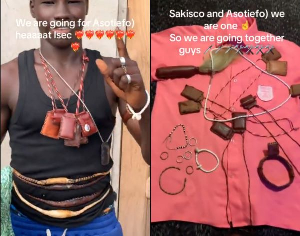The article with the above-mentioned title, from ghananewsagency.org., was published on Ghanaweb @ 2 February 2017. The said article provides an incorrect English name of the ‘alasa’ fruit. See extract below (re-produced from the article):
Traders of African star fruit, popularly known as “Alasa” in Accra are making huge profit due to the large public patronage of the product. The English name of ‘alasa’ is African star apple and its botanical name is Chrysophyllum albidum. It is different from starfruit (one word), whose botanical name is Averrhoa carambola.
Physically, the two fruits differ from each other. I will explain the difference using the etymology (the source or derivation) of the names. In the name African star apple, ‘apple’ describes the fruit shape which is similar to that of apple (Malus domestica). ‘Star’ describes the star-like manner in which the seeds are arranged in the fruit (Figure A). ‘African’ describes the origin of the plant. Therefore, all three names are required to identify the fruit correctly. Conversely, star apple (Chrysophyllum cainito) refers to an Asian fruit tree of the same family. Now to starfruit. The fruit itself has the star-like appearance (Figure B). That is, the ovary wall (technically the pericarp) indents to give the fruit a star-shape. For two reasons, I am not surprised about the incorrect name in the news story. The first reason is the neo-colonialist nature of our educational system. The first unit in integrated science for Primary 6 is Fruits and seeds (see the teaching syllabus 2012, p. 24). No textbooks mention the name of ‘alasa’ and those of other fruits that are indigenous to Ghana. Instead, these books are loaded with European fruits such as apple, grape, peach, acorn and blackberry. The authors, teachers and textbook evaluators at GES do not know the names of Ghanaian fruits and do not even see the need to know them either. To these authors and other educators, knowing and using Ghanaian fruits will make them appear local when they (the educators) want to appear international. The second reason is that worst errors of all kinds feature prominently in all syllabuses, textbooks, BECE and WASSCE papers and their marking schemes. And it remains a mystery as how and why those brightly shining errors go unnoticed for generations.
Let’s narrow the argument to incorrect use of words. We can draw two conclusions from the use of starfruit for African star apple. First, knowledge of the etymology of words is the surest way of using the right words wherever necessary. Second, learning must occur rotely in situation where one lacks knowledge on the etymology of words.
I will provide two examples from a teacher’s viewpoint, which shows how the lazy Ghana Education Service (GES) allows authors to imprint false information onto the minds of our schoolchildren. Again, the same laziness by GES allows WAEC to fail our children at both BECE and WASSCE.
If GES wants to challenge me, it should respond to all the documents I submitted to it about errors and inconsistencies in our educational system. If you (the reader) feel that my accusations are unsubstantiated, call Mr Cobbinah Enoch (Chief Director of the Ministry of Education) or Mrs Felicia Boakye-Yiadom (Director of CRDD) and ask them whether they have received any evidential information from me about unpardonable errors in our curricula. If they say ‘Yes’, ask them what they have thus far done to solve the problems. The educational authorities did absolutely nothing because they belong to cartels, which make more money when our students fail and have to resit for BECE and WASSCE. I am that happy Nana Addo’s Government will never tolerate such unethical behaviours. The then Ministers of Education especially Alex Kyeremeh were part of such cartels. He even mustered courage and went to Peace FM to defend the errors using his little knowledge. Thank God, he is gone from such a vital Ministry.
Our first example is the word pear. English language describes any thing that is shaped like a teardrop as pear shaped. Accordingly, the temperate fruit borne by Pyrus communis is called pear (Figure C). Similarly, the tropical fruit borne by Persea americana is called avocado pear (Figure D). Avocado pear (or simply avocado) is locally called ‘paya’. Because of this vernacular misconception, nearly all integrated science textbooks for lower and upper primary incorrectly used pear (a false fruit) for avocado (a true fruit). The most disgusting aspect of this an unethical error is that the textbooks downloaded the photos from the name site on the Net, yet they gave different names. For example, four major textbooks for primary school namely Alpha and Omega Series for primary 6 (p. 11), Jubilee Series for primary 6 (p. 4), Badu Nkansah for primary 3 (p. 72) and A.A. Series for primary 6 (pp. 2 and 3) all wrongly mentioned pear for avocado. How should a Ghanaian teacher not know the correct name for a crop that is indigenously grown in Ghana? Teaching in general and especially in the sciences begins with and ends in correct use of terms. Therefore, incorrect uses of words, called dictional errors, are the most dangerous errors in teaching. Their danger manifests in everyday conversation and in examination.
In everyday conversation, dictional errors make the reader to misinterpret the writer. An example is where the journalist intends telling us about African star apple (‘alasa’) but ends up using a different crop name—starfruit. At both BECE and WASSCE, most questions are the knowledge type in which candidates are asked to name or mention or list. There, the incorrect words are always marked wrong. This point explains why GES contributes greatly towards the failure of our students. The incorrect words are found in the government-approved textbooks. Here, I am justifiably extrapolating all kinds of errors to dictional errors and misspellings. Just imagine that an author cannot take time to copy down the correct word or its correct spelling, do you expect that author to give the correct definition or explanation of that term? No! Our second example is taken from Badu Nkansah integrated science for primary 4 (p. 34). See extract below: The movement of heat in liquids or gases is called CONVENTION. CONVENTION takes place in only liquids and gases. CONVENTION goes on in our homes every day. From the extract above, the textbook incorrectly used CONVENTION in place of CONVECTION. I called such an error ‘ a word-replacement error’. This error occurs when the writer uses a look- or a sound-alike word in place of the intended word. Such errors are committed by authors who have lack the required content knowledge or who write with absentmindedness. As for GES, they only wait for authors to bring manuscripts for approval and they approve the books by their titles without even reading the first page. Thus, GES does not know the contents of all textbooks in the system.
Other examples of word-replacement errors are given below. The incorrect words are in UPPERCASE whereas the correct words are parenthesized at the end of the sentences.
1. The sperms mix with the white liquid in the PROSTRATE glands to form semen. (prostate) Top Facts Integrated Science for primary 5 (p. 32)
2. The embryo contains the plumule and RADICAL. (Radicle) Calculus Series Integrated Science for primary 6 (p. 7)
3. The stomach is a muscular SACK that receives food. (sac) A.A. Series Integrated Science for primary 5 (p. 49) 4. Non-metals do not easily LOOSE their luster (an attractive SHINNY appearance) when polished. (lose & shiny)
5. Other units of mass are milligram, gram and TON. (tonne) Integrated science syllabus for JHS (2012, p. 3) 6. The electronic configuration of PHOSPHOROUS becomes 2,8,5. (phosphorus) EasyLearning Series for SHS (p. 29)
7. In areas where lands are generally SLOPPY, soil conversation …. (slopy) GAST Integrated Science for SHS (4th Edition, 368)
8. The LUMBER vertebrae are five in number …. (lumbar) Approacher’s Integrated Science for SHS (p. 165)
9. Nitrogen is also fixed through LIGHTENING during rainstorm. (lightning) Exotic Series General Agriculture for SHS (p. 88)
10. AUXILIARY bud (axillary bud) WASSCE May 2016 Marking Scheme Have you noticed how diversified such errors are in the educational system? Pupils and students themselves can hardly correct word-replacement and dictional errors. The errors above represent the combined knowledge of the authors and GES because all the textbooks cited above are government-approved. Therefore, an immediate and urgent option to the Nana Addo’s Government is the recruit subject-matter specialists and pedagogicians into CRDD. Any delay shows that we are gambling with our children’s education.
Just drop a comment! And we’ll add more. Long live practising teachers!
Idris Pacas 020 9101533 & iddrisuabdulai12@yahoo.com
Opinions of Monday, 6 February 2017
Columnist: Pacas, Idris














